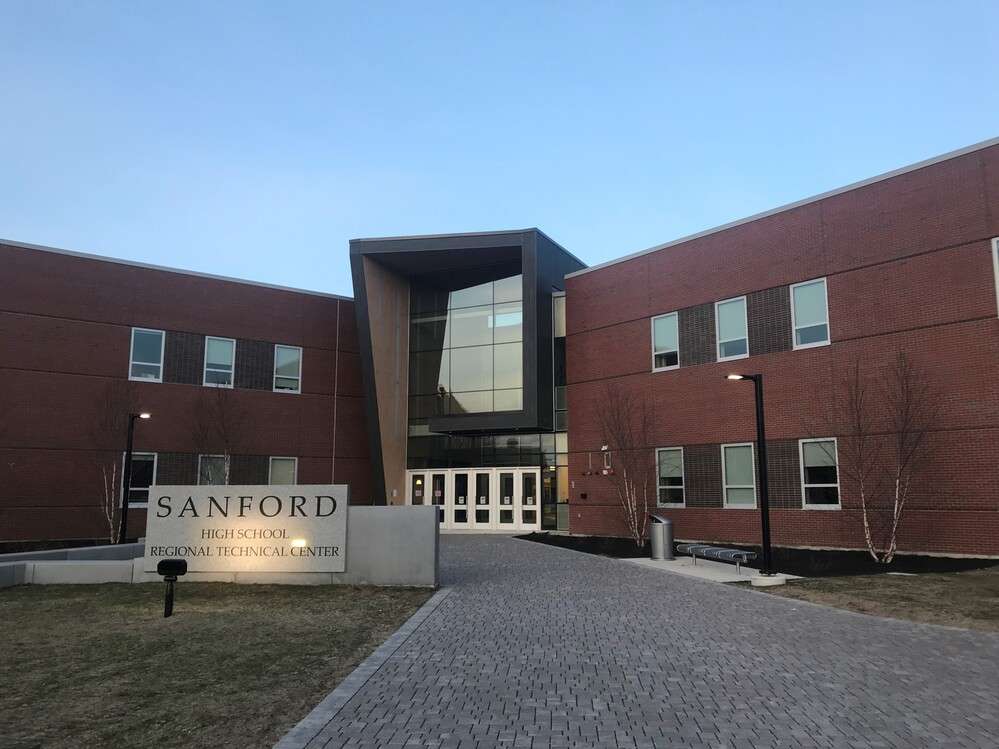Council Approves Single Polling Place for Sanford
- August 9th 2024
- City Council

Sanford High School will be the polling place for all of Sanford
Photo: City of Sanford
By Renée Morin
The City Council voted 5-2 on Tuesday to approve the consolidation of Sanford-Springvale’s three polling places to one, at Sanford High School, beginning with the Nov. 5 presidential election.
The two dissenting votes came from Councilors Nathan Hitchcock and Jonathan Martell, who suggested that the city should at least postpone the change because it could affect voter turnout. The vote followed a public hearing in which many residents shared their support for or concerns about the proposal.
Mayor Becky Brink first explained that Bangor, Biddeford, Brunswick, Saco, Waterville, and Westbrook each have one voting location. Sanford is one of eight communities in Maine to have multiple polling places.
The city has struggled to find poll workers, resulting in long hours for those they do find, Brink said. The current Ward 1 polling place at the Nasson Gym will no longer be available due to safety concerns for children at the daycare in the same building. Sanford High School has the benefit of being secure, large, city-owned, ADA-compliant, and in the center of Sanford, she said. Consolidation would save money and lessen the burden on poll workers, the city clerk, and the police, she added.
In total, 15 people spoke at the hearing. Due to the number of speakers and the full agenda for this meeting, Brink limited the speaking time to two minutes. The vast majority spoke in opposition to the proposal.
Ed Cormier, warden of the Ward 1 polling place, and Rep. Anne-Marie Mastraccio voiced support for the proposal. Rep. Ann Fredericks, Sen. Matt Harrington (via letter), and Jim Deyermond, chair of the York County Republican Committee opposed it.
Other Sanford residents spoke as well. Chris Hart said he worries that consolidation would hurt voter turnout. Pastor Todd Bell offered the former St. Ignatius Gym, now part of his church, as a polling place for this November. Brink thanked Bell for his offer but declined to use it as she worried it would be a conflict of interest. Bell’s wife Amy is a candidate for the state House of Representatives.
The most common arguments against the proposal were: the proximity of the consolidation to the presidential election, voter transportation to the high school, wait times to vote, and the effect on voter turnout. Some said they wished the city would wait until after the November election to make the change. Once the public hearing was finished, the councilors shared their thoughts on the proposal.
Hitchcock said he agrees that the high school is the best location to consolidate, but he is worried about voter access to transportation. He suggested that funds saved from consolidating polling places should be put toward covering the cost of transportation for voters. He said the council should have a solid plan in place for this issue. Because this could take time, he thought the city should wait until any issues are worked out.
Councilor Pete Tranchemontagne said he discussed the issue with several senators and Maine Secretary of State Shenna Bellows. He says that none of them had concerns about the consolidation. Tranchemontagne said he supports consolidation, especially since the Nasson site won’t be available. He also stressed that this wasn’t a partisan issue, and that he believes this will be better for the community.
Martell opposed the proposal, citing opposition he has heard from constituents. He said he worries that consolidation may affect voter turnout and suggested the change should be postponed.
Councilor Ayn Hanselmann supported consolidation. She argued that there were many ways that the city could inform residents of the change, including: in the planned flyer to accompany the city’s tax form, the city newsletter, the Sanford Springvale News, city social media, and the placement of signs around town. Hanselmann further argued that since the number of employees working at the polling places will remain the same, the wait time should not increase. Additionally, the high school will have 12 additional voting booths. She said that the high school is big enough to accommodate people waiting inside.
While transportation plans haven’t been finalized, York County Community Action has volunteered to provide drivers. The plan is that voters can call before noon the day before the election and arrange to be driven to the polls at their desired time.
Hanselmann said that the council wants everyone to vote. She suggested that the consolidation may be an opportunity to make voting a community event. She suggested that the city could have activities at the high school for residents when they are done voting.
Councilor Robert Stackpole thanked everyone who had worked on the consolidation and those that had come to speak at the hearing. Stackpole said that his main concern is public safety, and he believes the high school is best equipped to keep voters safe. Stackpole argued that given the likely turnout for this election, it is important for it to be safe and efficient. He also said that voters have the option to vote early or absentee if they do not wish to vote at the high school. Stackpole isn’t opposed to the city helping to pay for transportation, though.
Deputy Mayor Maura Herlihy shared that the council has been trying to consolidate the polling places for years now. She said that poll workers have been asking her for consolidation. She argued that 90 days was enough time, considering that one of the major political parties had only recently finalized its vice-presidential candidate and that the city doesn’t even have local candidates lined up for November. Herlihy said the presidential election is the perfect time to consolidate the polls, since consolidation will simplify the voting process.






